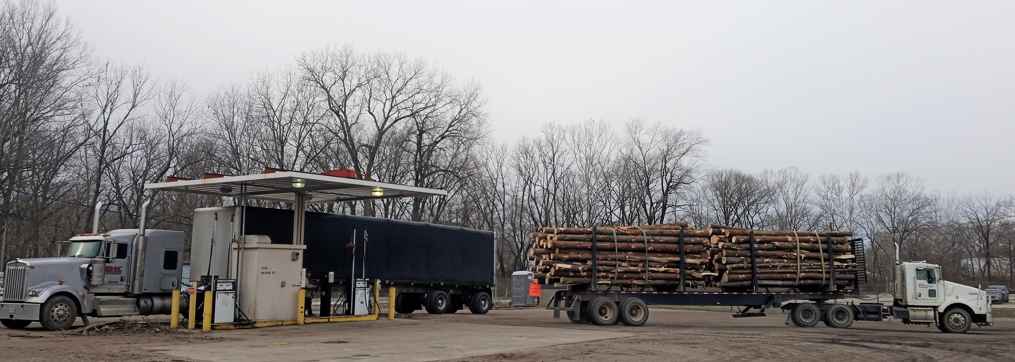Are You a Man or a Mouse? Truck Driver Appreciation

Last September, I anticipated my Woods to Mill blog would line up perfectly with National Truck Driver Appreciation Week, but unexpected schedule changes prevented that from happening. Fast forward to February 2022, and I had an opportunity to share a “day in the life” of truck owner, operator, and friend, John Spriggs, JFS Trucking Company, LLC in Waverly, OH.
His day started at 3:45 a.m. about the same time most of us are only dreaming about getting up. I met John at 8:00 a.m. He was heading back for his second load when he picked me up. Just getting into the truck was an accomplishment. I had to negotiate a 42-inch vertical climb, maintain three points of contact, and have the balance of a house cat! Truckers don’t have to set aside a special time to get their steps in. Just jumping in and out of a truck multiple times each day will accomplish that! John’s truck is a 2010 Kenworth with a day cab (no sleeper). He prefers older trucks for a few reasons. First, the new EPA emission standards for ultra-low sulfur fuel went into effect in 2007, with a phase-in period from 2007 -2010. John’s truck was the last year before DEF (Diesel Exhaust Fluid) was required. It converts diesel exhaust into a harmless nitrogen and water combination. The added cost of DEF, fuel efficiencies, repair/maintenance, and off-road requirements are a few reasons why he prefers older trucks. My expectation wasn’t complicated. I just wanted to sit in a comfortable passenger seat, as compared to the rumors I’d be sitting on an ol’ milk crate!
The first half of the trip was on a wide, well-marked, two-lane state highway, but the last 10 miles was an adventure! There’s a large Amish community living in the area, and at a distance, I could see a horse-drawn buggy riding the road at a blistering 15 mph. We approached the carriage with caution and stayed at a safe distance. Finally, we passed on a long, straight section of roadway. The paved road continued but narrowed, offering up blind curves, tight straight of ways, and steep hills. Our average speed had dropped to 35 mph. We even passed a bicycle coming in the opposite direction! I couldn’t help but notice John using his CB to reach out to other drivers. He needed to confirm they had cleared the job site. Why? Because there’s only room for one truck at a time on the haul road. Could you imagine trying to back that rig up? In our case, the road was open, and we were “cleared to land”. Our alternative was to wait on the state road, flashers blinking and guessing how annoyed the neighbors would get before calling the state highway patrol. Just a day earlier the haul road was impassable, and the limestone base seemed to have “sunk to China”! The cold, frozen ground of this morning provided a solid surface and made access into the sale easy. John says he replaces at least two tires per year due to off-road driving hazards. We were on site for 45 minutes. The loading time was average, unless you include waiting for a chainsaw to cut back the 2-foot chunk of wood that had gotten stuck under the log bunk.
The return trip was uneventful, but the truck was less responsive. We were hauling a full load of pine pulpwood, and the added weight seemed to be in control more than the driver. The bumps and sway of the load got my attention, and I noticed John kept both hands on the wheel. As we drove through town, the narrow city streets, traffic lights, and distracted drivers were a constant reminder that when you drive a truck, your “A” game is the “same” game, every day! No room for error and no time to daydream. The consequences are too high!
We stopped at the Southern Loggers Cooperative (www.southernloggers.com) fuel station, adjacent to the mill. The SLC is an agricultural cooperative started by loggers in 2004 to help combat rising fuel prices by leveraging fuel purchases to lower costs. The station opened in 2012, and John is a member. On that day, highway diesel fuel was $3.11/gal. Prices at other stations in the area ranged from $3.50 – $3.75/gallon. This was a significant saving, and John was quick to acknowledge his appreciation for the co-op. I was quick to acknowledge that I could see my car! My ride was over.
In conclusion, the transportation sector of the forest products industry is facing strong headwinds. Drivers are retiring – or just leaving – in record numbers. In 2021 the American Trucking Associations (ATA) estimated the driver shortage is at a historic high.
The FRA continues to provide support to the trucking sector of our industry through legislative support, trucking webinars, pilot projects, Team Safe Trucking (www.teamsafetrucking.com), and the Women in Trucking Association. Working together is the only way we will accomplish anything. This includes listening, understanding, and addressing issues that truckers deal with every day. Using over-the-road formulas to calculate rates, excessive mill turn times, and poor planning are all barriers preventing a strong transportation sector. They say, “Before you judge a man, walk a mile in his shoes.” If you’re brave enough, I encourage anyone to take a ride with a trucker who you know and trust! When you get back, tell them what you thought and that you appreciate what they’re doing for your business, and remember:
National Truck Driver Appreciation Week – September 11-17, 2022.
Put that one on the calendar!


